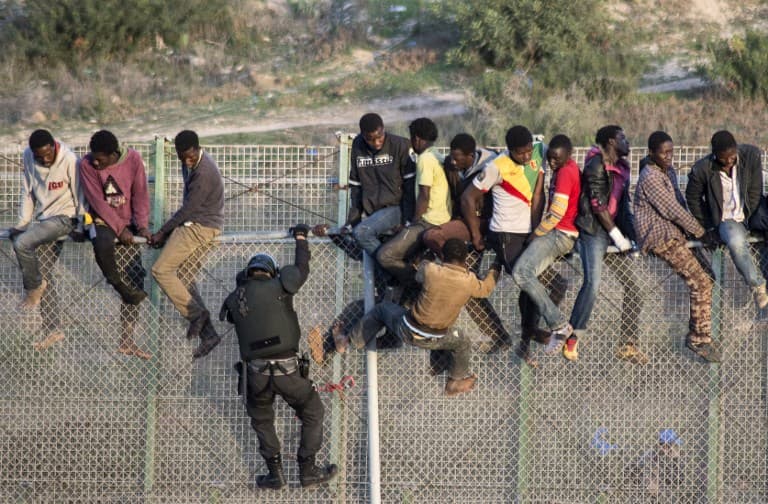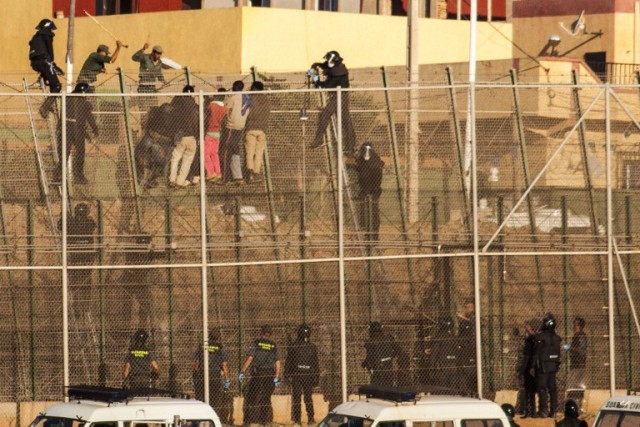Trump's wall: Spain shows why US president is heading for trouble

A year ago Donald Trump's first TV campaign ad showed footage of immigrants trying to flee to a Spanish enclave as he pledged to build a wall on the US border with Mexico. After the US President promised to press ahead with the plan, we take a closer look at Spain's two border fences.
Where are Spain’s border fences?
Spain has long tried to keep immigrants from illegally entering Melilla and Ceuta, the country’s two enclaves bordering Morocco.
The areas represent the European Union’s only land border with Africa. Each year thousands of mainly sub-Saharan Africans attempt to breach the barriers in search of a better life in Europe.
READ ALSO: Trump ad actually shows migrants storming Spain border NOT Mexico
How old are the fences?
Spain started building the fences in 1998 and fortified them further in 2005. The EU has since contributed more funding for reinforcements.
Topped with barbed wire, two of the Melilla fences are six metres high, while the third is a three-metre structure. They have a combined length of 12 kilometres. The Ceuta fence is eight kilometres long and six metres high.
READ ALSO: 1,100 migrants storm Spain’s enclave in Ceuta
How effective are they?
They are generally quite effective in keeping people out, but are routinely stormed and human rights groups have accused both the Spanish and Moroccan border police of mistreating immigrants.
The fences are located on the Spanish side of the border and the country’s so-called pushback policy of walking immigrants back to the Moroccan side without affording them protections guaranteed by EU law has come in for scathing criticism.
Human rights groups have been joined by the Council of Europe’s Committee for the Prevention of Torture, the UN’s refugee agency, and the European Union’s home affairs commissioner in condemning these “hot returns”.
Spain’s controversial 2015 gag law reforms also paved the way for immigrants caught illegally entering Melilla or Ceuta to be collectively expelled, despite international laws banning the practice.

Members of the Spanish Guardia Civil look on as two members of the Moroccan Auxiliary Forces hit would-be immigrants. Photo: AFP
READ ALSO: Six reasons why Spain is failing on human rights
How are Moroccan-Spanish relations in Ceuta and Melilla?
Tense. Morocco wants the regions for itself and doesn’t agree they are an integral part of Spain, which conquered Melilla in 1497.
Who lives there?
Ceuta has a population of about 82,000, while 78,000 people live in Melilla. Spanish is the most widely spoken language. The huge security presence has seen them described variously as gated communities and open-air prisons.
Have there been any serious incidents?
Too many to count, but the deadliest events both occurred in Ceuta. In 2005 at least 14 Africans died after they were shot at by Moroccan and Spanish forces.
Then, in 2014, Spanish police allegedly fired rubber bullets and tear gas at African immigrants attempting to swim to Ceuta, killing 15 people. The regional court in Ceuta has ordered the case to be investigated further.
READ MORE: Judge summons 16 police officers over deadly Ceuta drownings
What do human rights groups say?
Amnesty International was furious after the 2014 Ceuta deaths:
“Spain’s Secretary of State for Security says the officers weren’t permitted to enter foreign waters. So the border stopped them from rescuing drowning men, but it did not stop the rubber bullets. At least fourteen people paid with their lives.
“What happened that day is the starkest example yet of the Spanish Government’s border policy: No entry. At any cost.”
In its recent world report, Human Rights Watch wrote:
"A policy of summary returns and reinforced controls at Spain’s land border with Morocco in its North Africa enclaves appeared to result in migrants increasingly trying to reach Ceuta and Melilla by boat or swimming. The number of deaths along that route tripled to 45 in the first six months of 2016 compared to 2015."
The European Centre for Constitutional and Human Rights (ECCHR) said:
"Research from local and international NGOs and video footage confirm that automatic expulsions of Sub-Saharan individuals at the Melilla border fence frequently result in their severe mistreatment by Moroccan forces. This ill-treatment is both preventive and punitive and involves a very high level of violence. This is known by members of the Spanish forces and sometimes happens in plain view of them, as happened in the present case on 13 August 2014."
"Despite these alarming reports, both the EU and Spain continue intensifying their border management externalization policy, thus escaping their obligations under the European Convention on Human Rights."
Are there any plans to tear down the fences?
No.
Why should Donald Trump care?
If the Spanish experience is anything to go by, human rights groups will be all over him like a rash. He also risks further alienating Mexico and will have to contend with more hurdles in the form of conservationists and high costs.
But will he care? Given the personal prestige he has invested in the project, probably not.
Comments
See Also
Where are Spain’s border fences?
Spain has long tried to keep immigrants from illegally entering Melilla and Ceuta, the country’s two enclaves bordering Morocco.
The areas represent the European Union’s only land border with Africa. Each year thousands of mainly sub-Saharan Africans attempt to breach the barriers in search of a better life in Europe.
READ ALSO: Trump ad actually shows migrants storming Spain border NOT Mexico
How old are the fences?
Spain started building the fences in 1998 and fortified them further in 2005. The EU has since contributed more funding for reinforcements.
Topped with barbed wire, two of the Melilla fences are six metres high, while the third is a three-metre structure. They have a combined length of 12 kilometres. The Ceuta fence is eight kilometres long and six metres high.
READ ALSO: 1,100 migrants storm Spain’s enclave in Ceuta
How effective are they?
They are generally quite effective in keeping people out, but are routinely stormed and human rights groups have accused both the Spanish and Moroccan border police of mistreating immigrants.
The fences are located on the Spanish side of the border and the country’s so-called pushback policy of walking immigrants back to the Moroccan side without affording them protections guaranteed by EU law has come in for scathing criticism.
Human rights groups have been joined by the Council of Europe’s Committee for the Prevention of Torture, the UN’s refugee agency, and the European Union’s home affairs commissioner in condemning these “hot returns”.
Spain’s controversial 2015 gag law reforms also paved the way for immigrants caught illegally entering Melilla or Ceuta to be collectively expelled, despite international laws banning the practice.

Members of the Spanish Guardia Civil look on as two members of the Moroccan Auxiliary Forces hit would-be immigrants. Photo: AFP
READ ALSO: Six reasons why Spain is failing on human rights
How are Moroccan-Spanish relations in Ceuta and Melilla?
Tense. Morocco wants the regions for itself and doesn’t agree they are an integral part of Spain, which conquered Melilla in 1497.
Who lives there?
Ceuta has a population of about 82,000, while 78,000 people live in Melilla. Spanish is the most widely spoken language. The huge security presence has seen them described variously as gated communities and open-air prisons.
Have there been any serious incidents?
Too many to count, but the deadliest events both occurred in Ceuta. In 2005 at least 14 Africans died after they were shot at by Moroccan and Spanish forces.
Then, in 2014, Spanish police allegedly fired rubber bullets and tear gas at African immigrants attempting to swim to Ceuta, killing 15 people. The regional court in Ceuta has ordered the case to be investigated further.
READ MORE: Judge summons 16 police officers over deadly Ceuta drownings
What do human rights groups say?
Amnesty International was furious after the 2014 Ceuta deaths:
“Spain’s Secretary of State for Security says the officers weren’t permitted to enter foreign waters. So the border stopped them from rescuing drowning men, but it did not stop the rubber bullets. At least fourteen people paid with their lives.
“What happened that day is the starkest example yet of the Spanish Government’s border policy: No entry. At any cost.”
In its recent world report, Human Rights Watch wrote:
"A policy of summary returns and reinforced controls at Spain’s land border with Morocco in its North Africa enclaves appeared to result in migrants increasingly trying to reach Ceuta and Melilla by boat or swimming. The number of deaths along that route tripled to 45 in the first six months of 2016 compared to 2015."
The European Centre for Constitutional and Human Rights (ECCHR) said:
"Research from local and international NGOs and video footage confirm that automatic expulsions of Sub-Saharan individuals at the Melilla border fence frequently result in their severe mistreatment by Moroccan forces. This ill-treatment is both preventive and punitive and involves a very high level of violence. This is known by members of the Spanish forces and sometimes happens in plain view of them, as happened in the present case on 13 August 2014."
"Despite these alarming reports, both the EU and Spain continue intensifying their border management externalization policy, thus escaping their obligations under the European Convention on Human Rights."
Join the conversation in our comments section below. Share your own views and experience and if you have a question or suggestion for our journalists then email us at [email protected].
Please keep comments civil, constructive and on topic – and make sure to read our terms of use before getting involved.
Please log in here to leave a comment.